Samsung Galaxy S20 Ultra review: Too much more for most
- 06 March, 2020 22:00

I feel like I need to give Samsung’s Galaxy S20 Ultra two scores. If I’m reviewing it solely on the merits of its components and what it can do, it’s easily a five-star device, with only the smallest of perceptible flaws.
The 6.9-inch display is remarkably bright and incredibly smooth when the 120Hz refresh rate is switched on, and the 40MP hole-punch selfie camera is much more discreet than it was on the S10. The RAM, storage, and processor are all the fastest you can get in a smartphone, and the 5,000mAh battery both lasts all day and fills up incredibly quickly. And yes, the 100X Space Zoom camera is cooler than any other telephoto lens I’ve used.
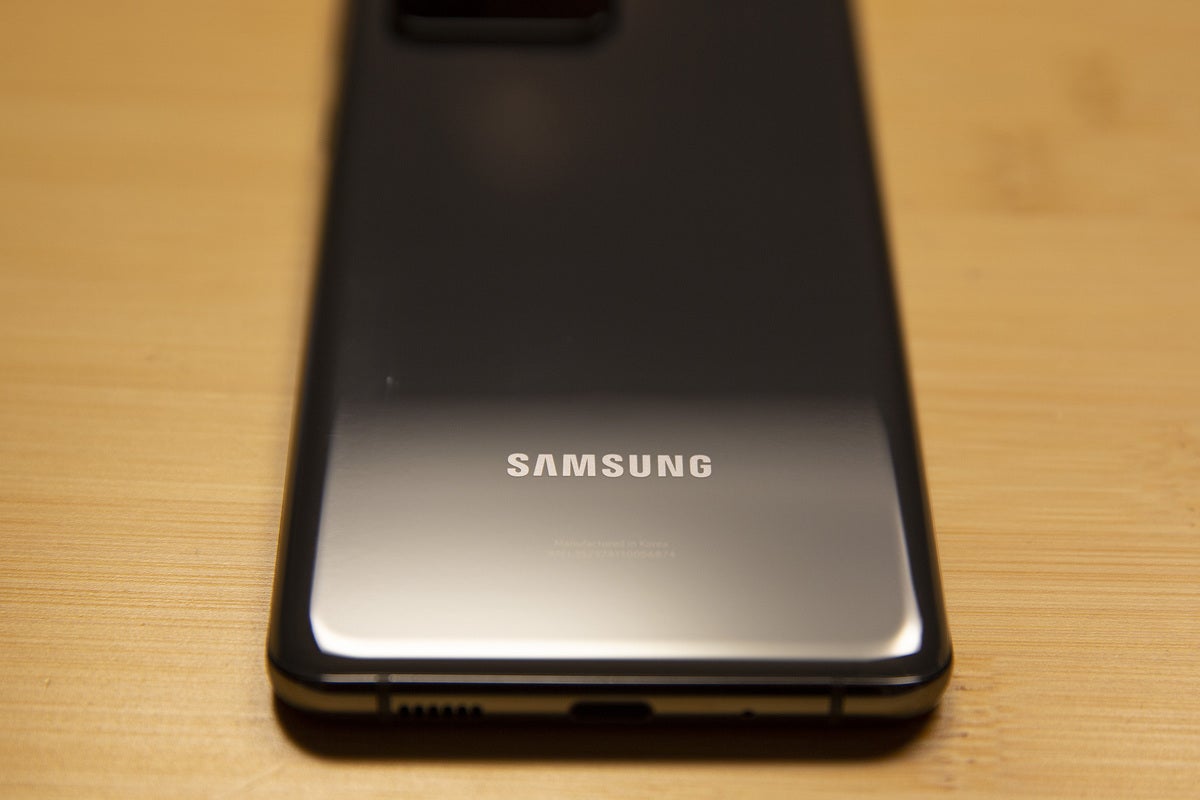 Christopher Hebert/IDG
Christopher Hebert/IDG
You won't find the S20 Ultra name anywhere on the phone, but everyone will know what it is.
But if I were to score the Galaxy S20 Ultra on usability and cost, I’d give it closer to 2 stars (hence the 3.5-star final score). Even if it didn’t start at $1,400, a price high enough to make Apple blush—and our review model is the $1,600 step-up—the Galaxy S20 Ultra would still be far too much phone for most people. Everything feels extreme, especially its size. Samsung's push to make the ultimate device has created a gorgeous and awe-inspiring superphone that is far beyond what most people need. Or even want. (Curious about the lower-cost S20 models? Check out our comparison of the Samsung Galaxy S20 vs. the S20+.)
Big, heavy, and awkward
For several generations now, Samsung has established that its “plus” phones are essentially larger versions of base models with better cameras. On paper, that’s true of the S20 Ultra as well, but in reality, it’s much more than a super-sized Galaxy S20+.
I don’t usually spend much time thinking about the weight of my phone, but it’s hard to ignore the S20 Ultra’s mass. At 222 grams, it’s significantly heavier than S20+ (188g) and the S10 5G (198g). It’s actually a bit lighter than the iPhone 11 Pro Max, which clocks in at 226 grams, but you wouldn’t know it from holding it. With such a massive camera bump in the top left corner, the S20 Ultra is both top-heavy and side-heavy, so it requires a slightly different grip, lest it slide and slip out of your hands.
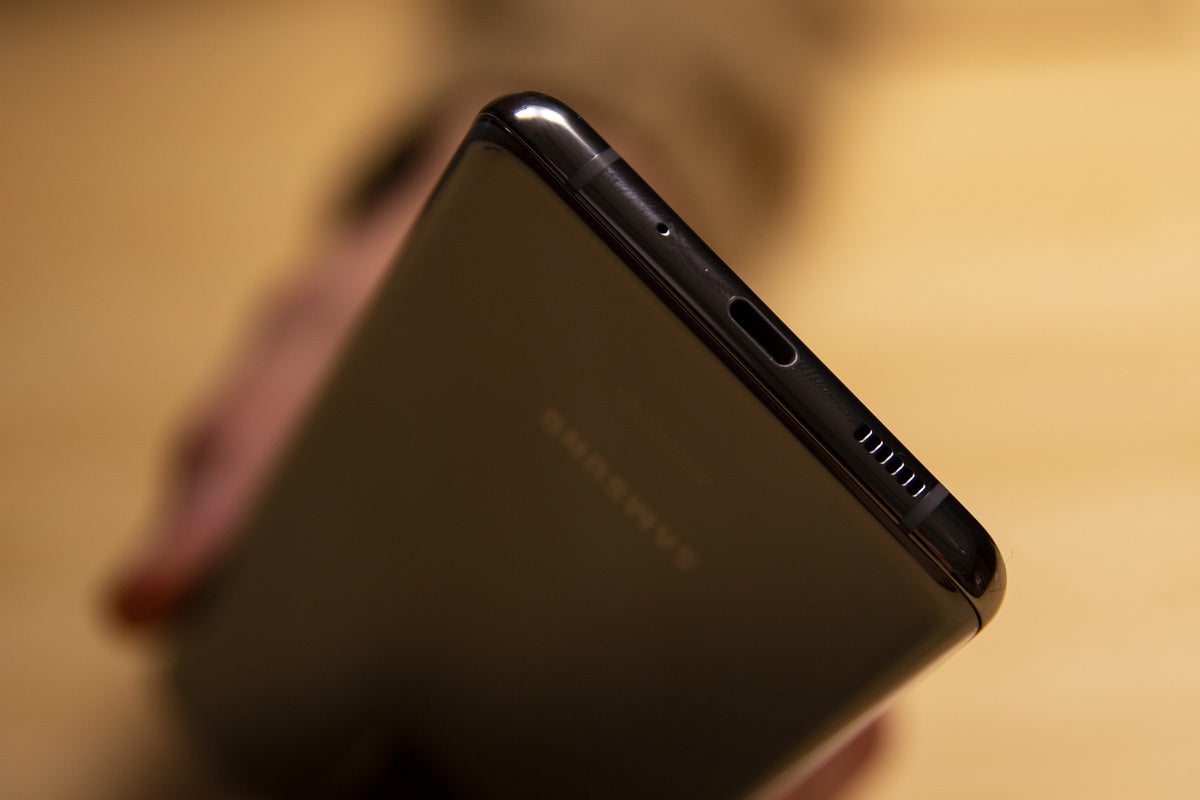 Christopher Hebert/IDG
Christopher Hebert/IDG
The S20 Ultra's USB-C port is finally perfectly centered on the bottom edge.
You can forget about one-handed operation. While the new, higher placement of the in-display fingerprint sensor has drastically improved the accuracy and reliability of the scanner when picking it up and unlocking with my thumb, the size of the S20 Ultra makes it difficult to do much else without using all 10 of my fingers. It was hard enough to use the 6.8-inch display on the Note 10+, but the S20 Ultra’s 6.9-inch screen, coupled with the weight and near-9mm thickness, is simply too much for one hand to bear.
The S20 Ultra is the only phone I’ve used that I could actually feel sliding down my hand as I held it. It’s a weird phenomenon, caused by a combination of the size, weight, and polished aluminum edges. Eventually, I settled on a grip that either contorted my pinkie finger under the bottom or used my off-hand thumb to keep it steady. I still had to adjust my grip every so often. Long stretches with the Ultra were downright uncomfortable.
 Christopher Hebert/IDG
Christopher Hebert/IDG
The S20 Ultra absolutely towers over the Galaxy S10+, which isn't exactly small.
Even if you have fingers long enough to comfortably reach the upper corners of the screen, the bulbous camera will complicate your grip. While giant geometrical camera arrays are all the rage, the S20 Ultra takes it to almost comical proportions, with a bump that protrudes some three millimeters from the back. Because it’s such a broad bump, taking up about an eighth of the rear case, your fingers will inevitably butt into it.
The giant camera bump also makes it tricky to use on a table, especially when tapping the upper left side of the screen. It’s wobblier than the S10 and the Pixel, and when a notification comes in, the haptic vibration is downright startling. All said, it’s the first phone I wanted to put in a case, which is a shame, because the glass repels fingerprints surprisingly well.
Elsewhere, it's easier to raise the volume, as the rocker has been moved to the right side above the power button. That leaves the left side completely smooth, because Samsung has dumped the Bixby button once and for all.
Gone, too, is the headphone jack, which we expected after the Note 10+ dropped the port last year. Samsung is offering a pair of USB-C earbuds in the box and selling a set of Bluetooth Galaxy Buds+ earbuds for $150. It’s still a bummer that Samsung couldn’t find 3.5 millimeters of free space on a phone this big.
Pixel perfection
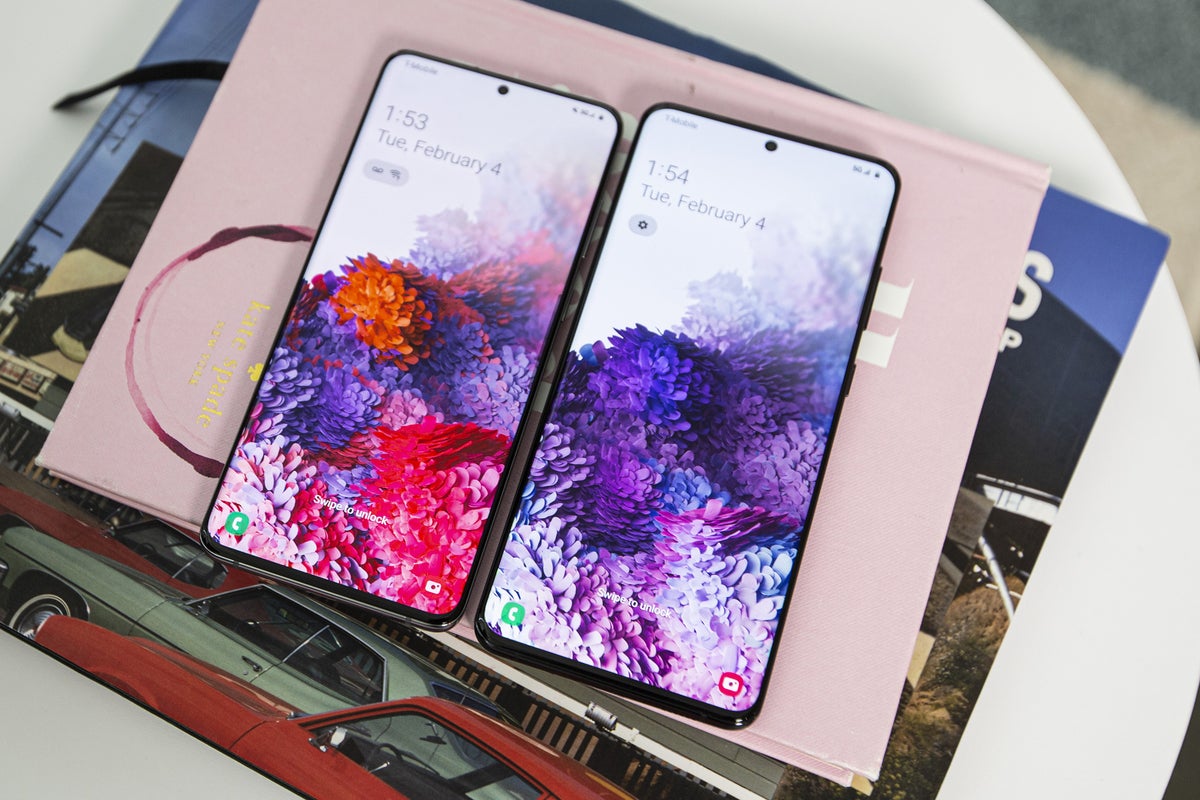 Christopher Hebert/iDG
Christopher Hebert/iDG
The front camera in the S20 line has moved to the middle of the top of the screen, a positive change from the awkwardly off-center hole of the prior generation. (As shown in the S20 and S20+, above)
Samsung has delivered its most impressive display yet for the S20 product line—and that’s before you even touch it. The weirdly off-center camera cutout of the S10 product line has been repositioned in the S20 so it’s smack-dab in the center of the top of the screen. While the hole is still a little too low to center itself inside the status bar, its new position still improves the look of the phone.
I can’t really find a fault with the image quality. It’s impressively crisp at 1440p and still very nice at the default 1080p resolution. I was able to crank it all the way up to 650 nits' brightness manually, and it reached an eye-piercing 1,350 nits with auto-brightness enabled. Its ability to transition automatically between low and bright light is excellent. Colors are vivid without being too saturated, whites are natural, blacks are impressively deep, and the whole palette is rich and robust. There just aren’t enough superlatives for how incredible the S20’s display is.
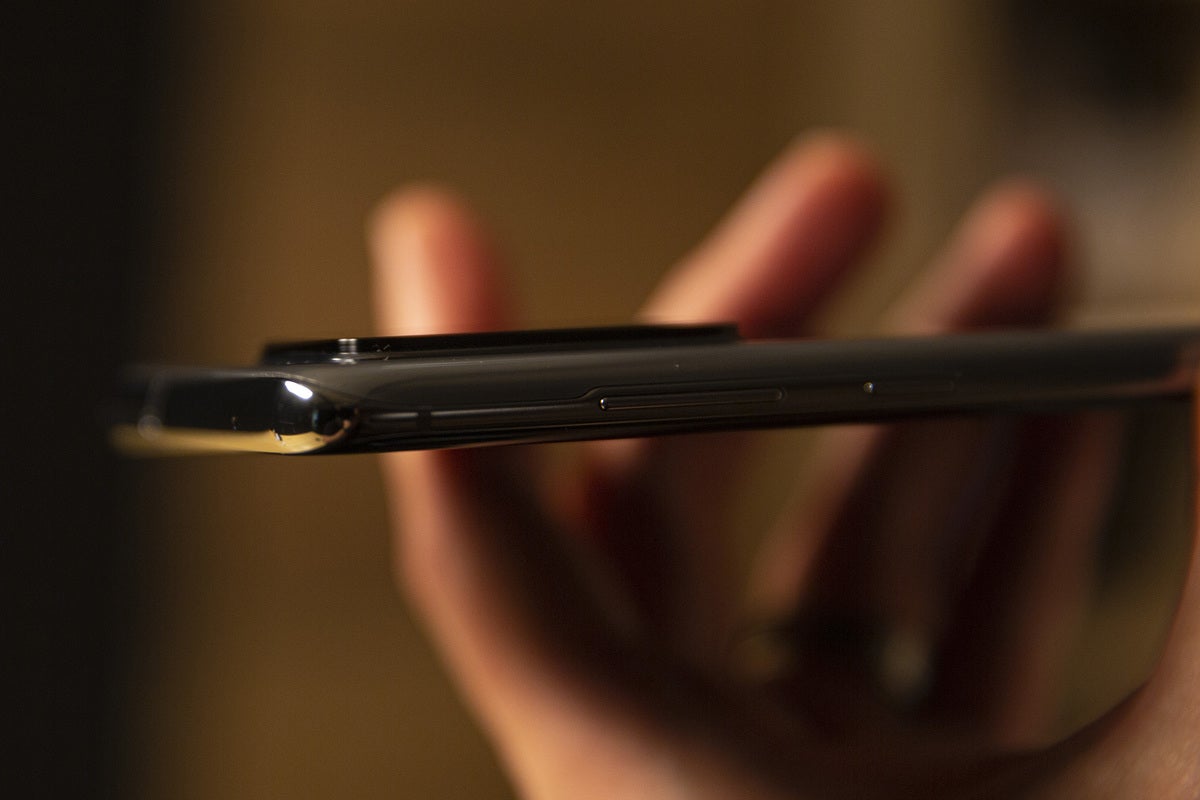 Christopher Hebert/IDG
Christopher Hebert/IDG
That's no moon, that's the 100X Space Zoom camera bump.
It’s also not quite as curved as previous Infinity displays. It’s hard to see without putting it next to a Note 10 or S10, but the S20 screen is decidedly “flatter” than those of previous generations (though definitely more curved than the S10e's). That’s a good thing: It helps cut down on accidental palm touches and still does well to hide the side bezels. I vastly prefer it to the extreme “waterfall” displays that Oppo and Vivo are pushing.
Samsung has once again gone with an ultrasonic in-display fingerprint sensor on the S20 family. While a thousand-dollar-plus phone should really have 3D facial recognition, this implementation of the fingerprint sensor is much improved over what we had with the S10. The position of the scanner is higher on the screen and the target is a bit bigger, so I didn’t need to alter my grip or flex my thumb to hit it. It’s still not quite as consistently fast as the hardware sensor on the S9 and probably never will be, but it’s plenty accurate and reliable now.
The best feature on the S20 display is actually switched off by default (and I’m not talking about the usual WQHD 1440p resolution). The S20 is Samsung’s first product line to feature a high-refresh display, and it’s gone for the gusto, opting for a full 120Hz, twice as fast as the standard 60Hz. It’s glorious. Compared to the standard 60Hz setting, scrolling, animation, and gaming are fantastically smooth, well worth the serious hit to battery life when it’s switched on.
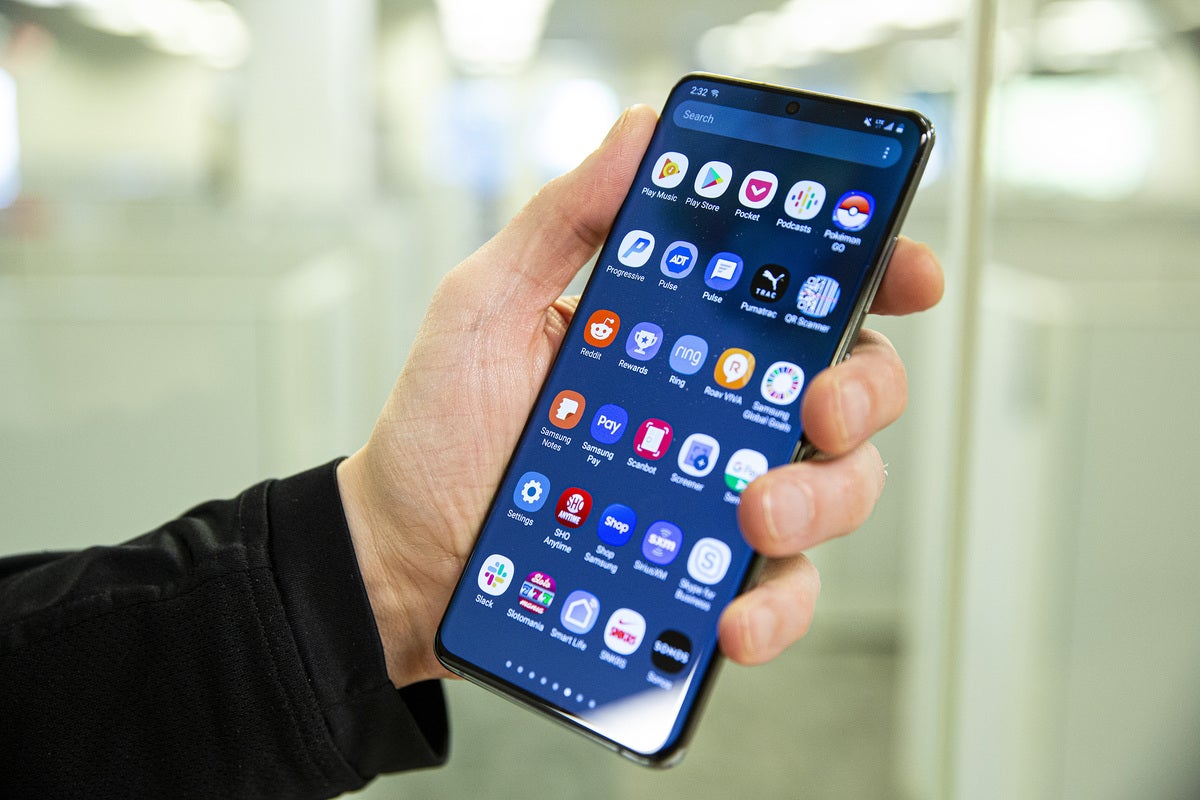 Christopher Hebert/IDG
Christopher Hebert/IDG
You can fit an awful lot of app icons on the Galaxy S20 Ultra's screen.
When pitted against the Pixel 4’s 90Hz Smooth Display, however, the difference is not nearly as obvious. Samsung could easily have gotten away with 90Hz, saved some battery life, and offered it for 1440p resolution as well, but as it stands the 120Hz setting is available only with Full HD 1080p resolution. Fast refresh with WQHD would have been nice, especially on a screen this size—I’m holding out hope that Samsung will unlock it with a future update. Despite that limitation, however, the 120Hz screen is one of the best reasons to buy any S20 phone.
Speed to spare
Galaxy phones have been fast enough since the Snapdragon 820 processor in the Galaxy S7, but the Snapdragon 865 in the S20 line is on another level. Snapdragon 855 Plus-powered phones had already broken the 10,000 threshold on the PCMark Work 2.0 benchmark, the S20 crushes expectations with a score of 12,350.
While the speed boost is palpable, Qualcomm doesn’t deserve all of the credit. Samsung is using entirely new RAM modules inside the S20, and every handset is packed with at least 12GB of LPDDR5 memory. Plus you’re able to keep three apps open for faster switching, so launching games with lengthy startup times are lightning-quick. To give you an idea of how it feels to have this much RAM: I stopped counting the apps on my Recents screen at 50.
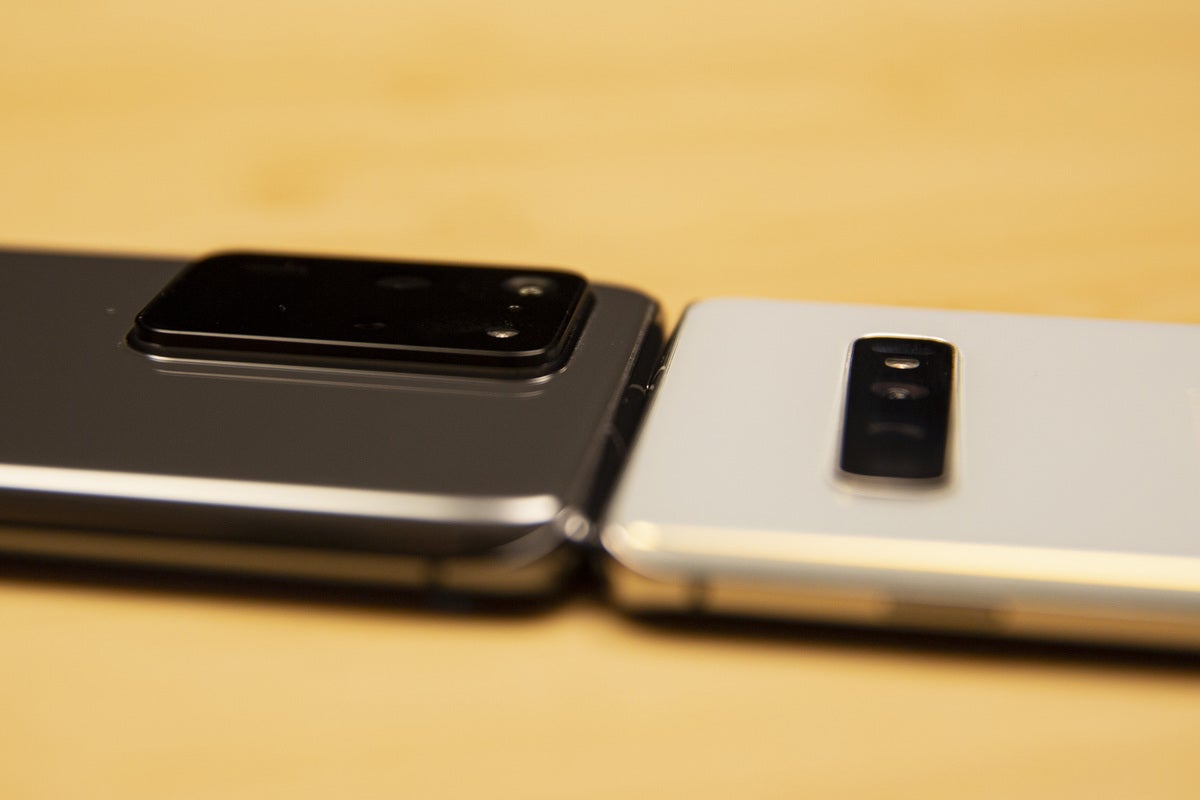 Christopher Hebert/IDG
Christopher Hebert/IDG
Compared to the S10, the Ultra's camera is a monster.
Even the SSD has improved. It’s not just the 128GB capacity—once again, twice as much as the Pixel and iPhone—but the speed: Samsung is using UFS 3.0 storage on all S20 models. While it’s not quite as fast as the UFS 3.1 storage that will probably debut in the Note 20, it’s a huge jump over what you got with the S10, and it even bests other UFS 3.0 phones (though I’m not sure what’s going on with random write results):
S20 (UFS 3.0)
Sequential read: 1,592.46 MBps
Sequential write: 662.75 MBps
Random read: 45,172.27 IOPS
Random write: 33,764.08 IOPS
S10 (UFS 2.1)
Sequential read: 802.13 MBps
Sequential write: 188.34 MBps
Random read: 34,612.61 IOPS
Random write: 7,383.57 IOPS
OnePlus 7T (UFS 3.0)
Sequential read: 1,436.19 MBps
Sequential write: 210.4 MBps
Random read: 44,158.73 IOPS
Random write: 7,189 IOPS
Add up the chip, RAM, and storage, and you’ve got a downright monster of a phone that's faster than most Chromebooks and can even give some PCs a run for their money. It’s so powerful, Samsung could probably rest on its laurels for the next two generations and still keep pace with its competitors.
Keep reading to see how that huge battery does in our tests, and more.
Page Break
Great battery, so-so 5G
Samsung has loaded the S20 Ultra with a 5,000mAh battery—its biggest ever, and a sign that it’s finally ready to push the limits of battery capacity after the Galaxy Note 7's exploding-battery debacle.
The S20 needs it. With 5G active and 120Hz motion smoothness flipped on, I was barely able to make it through a full day of heavy use. With the 120Hz refresh off, WQHD on, and 5G enabled, I was able to last a good part of a second day, which is iPhone 11 Pro Max territory. Benchmarks topped 10 hours in both cases, but 120Hz zapped more than three hours of use, so you’ll definitely want to consider whether it’s worth it to you.
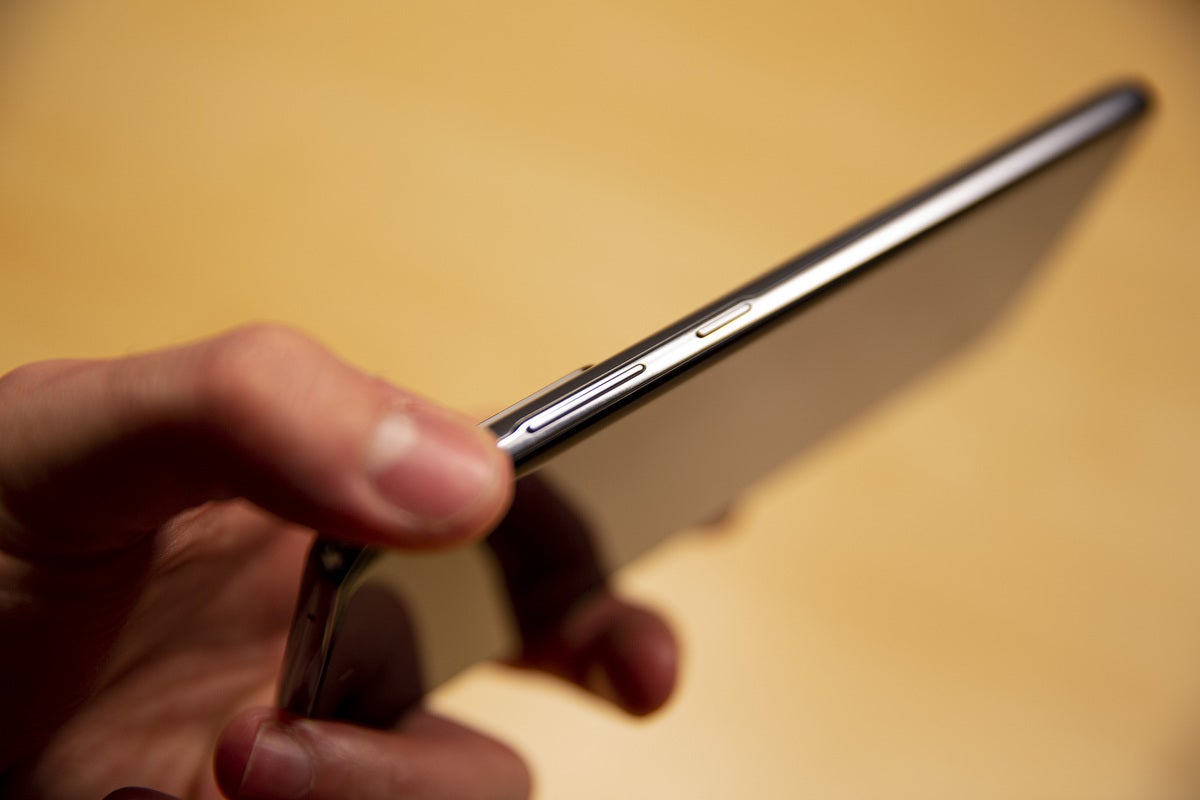 Christopher Hebert/IDG
Christopher Hebert/IDG
The buttons on the S20 Ultra have all been moved to the right side.
The same goes for 5G. While all S20 phones sold in the United States will have a 5G modem, you can opt to turn it off in settings, which will give battery life a slight uptick. That’s obviously something you’ll want to do if you’re under an LTE plan, but even if you have subscribed to T-Mobile’s or Verizon’s 5G plan, the benefits might not be as great as you’ve been led to believe.
While it’s well-documented that Verizon’s mmWave 5G speeds are stupid fast, they’re limited to very small pockets around the United States. I tested the S20 Ultra using T-Mobile’s network in Connecticut, and my mileage varied. Even when my S20 Ultra said it was connected to a 5G network, my speeds were often lower than my Pixel 4's on Verizon’s LTE network. Occasionally I topped 100Mbps, but none of it felt transformative or any better than LTE.
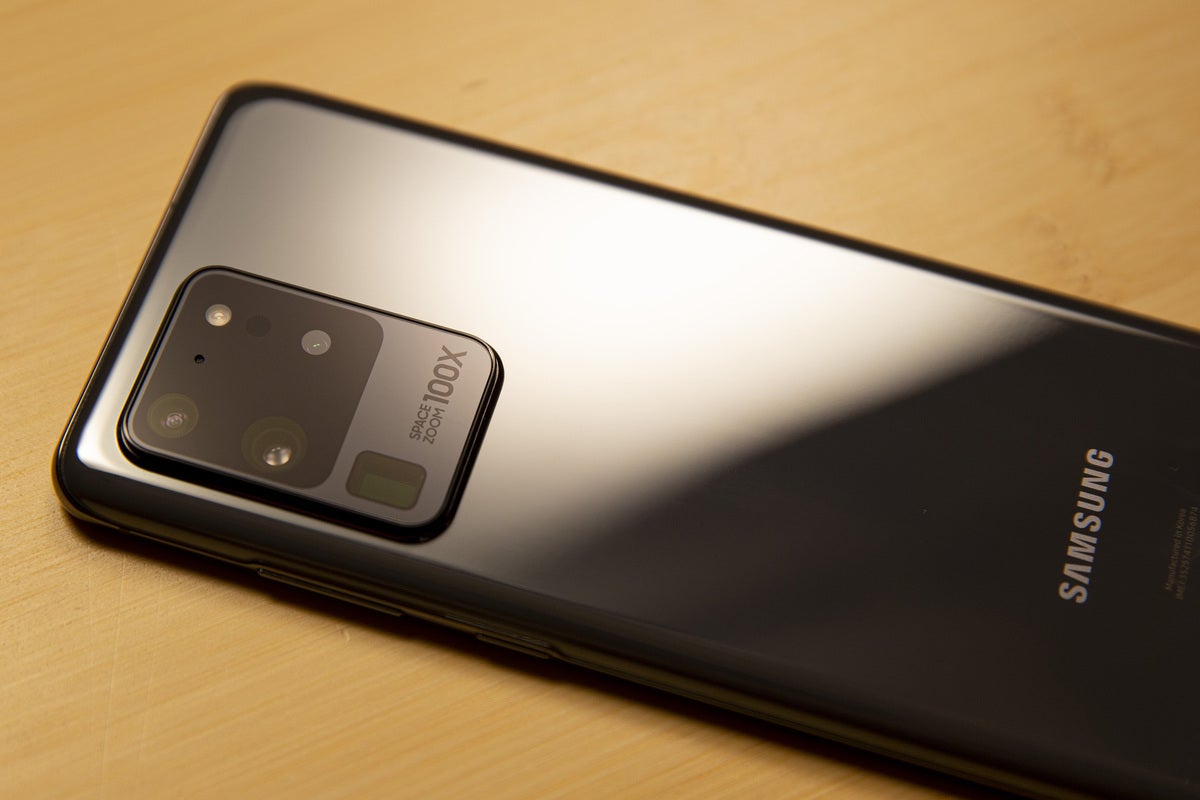 Christopher Hebert/IDG
Christopher Hebert/IDG
The S20 Ultra isn't available in any funky colors, but even in gray, it cuts a striking figure.
Even if you don’t take advantage of the 5G modem now, you can be assured that the S20 Ultra will be as future-proofed as it can be, for as long as you hold onto it. With support for both mmWave and Sub-6GHz 5G, 12GB of RAM, a fast processor, speedy storage, and an insanely great display, the S20 Ultra is primed for years of solid performance.
An Android skin worthy of praise
It’s not just the hardware that’s future-proofing the S20. For the first time since I’ve been testing Galaxy phones, I’m confident that Samsung will keep the S20 line as fresh as possible with regular and timely updates. Exhibit A: It’s March 3 as I’m writing this, and my S20 Ultra already has the March Security Update, the third straight month that one of my Samsung phones has gotten an Android update earlier than my Pixel 4 has. That’s a huge accomplishment and hopefully a sign of things to come with Android 11 later this year.
One UI has completely transformed the Samsung smartphone experience from a so-so skin to one of the best user interfaces Android has to offer. The S20 family ships with One UI 2, and while it’s very much an iterative update, the new features it brings—including an expansion of dark mode and the adoption of a proper back gesture—are as smart and thoughtful as they are on the Pixel 4.
One UI 2 is a bona fide contender for the best Android overlay of the year, and far and away the most creative in the Android world right now. If Samsung can deliver One UI 3 at or around the time Android 11 drops, there will be very few remaining reasons to buy another Android phone.
A great camera with caveats
While there are plenty of reasons above to justify the S20’s Ultra surname, the camera is the biggest. Inside that huge bulge is an array of large, powerful sensors and lenses that can do more than any other smartphone camera ever made.
 Christopher Hebert/IDG
Christopher Hebert/IDG
The S20 Ultra's zoom isn't quite DSLR-quality, but it's the closest a smartphone has ever been.
Like the rest of the S20 Ultra, the camera is on the absolute cutting edge of available components. You’re unlikely to find another smartphone that bests it on paper. Like the S20+, the Ultra has four rear cameras, and they're all different:
S20 Ultra
Camera 1: 12MP Ultra Wide, f/2.2
Camera 2: 108MP Wide-angle, f/1.8
Camera 3: 48MP Telephoto, f/3.5
Camera 4: DepthVision (time-of-flight)
S20+
Camera 1: 12MP Ultra Wide, f/2.2
Camera 2: 12MP Wide-angle, f/1.76
Camera 3: 64MP Telephoto, f/2.0
Camera 4: DepthVision (time-of-flight)
Whether those S20 Ultra specs actually make a difference in your day-to-day picture-taking is another story. There’s a 108MP sensor that most people will never turn on. There’s a 100X zoom that most people will never need. And it can record in 8K, which most people will never—well, you get the idea.
 Michael SImon/IDG
Michael SImon/IDG
The various preset zooms on the S20 Ultra, clockwise from top left, 1X, 10X, 30X and 100X, show how incredible the telephoto lens is.
While the 108MP sensor obviously stands out on the Ultra, the telephoto lens is the real star. Samsung’s claims are true—it can reach up to an insane 100X—but you’re unlikely to use it at that distance very often. As you can see above, the pictures it captures aren’t really ones you’ll want to display. Plus there's the creep factor: I was able to see clear across my wide yard into my neighbor’s kitchen window. Still, when you see just how far it can go, it’s pretty mind-blowing.
 Michael Simon/IDG
Michael Simon/IDG
These three photos taken by the S20 (left), iPhone 11 (center), and Pixel 4 XL (right) are so similar, I had a hard time remembering which was which.
The S20 Ultra is even more impressive when you zoom out. While 2X or 3X optical zoom is pretty standard for premium Android phones, Samsung says the S20 Ultra has a 10X “lossless” zoom that combines 4X optical and 6X digital zoom with AI to reduce the noise you'd normally get with digital zoom. It’s quite good: Photography purists will still see some telltale digital smartphone artifacts at 10X, but it’s an excellent first step, and the quality should improve with steady updates.
 Michael Simon/IDG
Michael Simon/IDG
In challenging lighting, the S20 Ultra (left) performed admirably, retaining detail that the Pixel 4 lost (right) and preserving low lights that the S10 blew away (center).
Speaking of improvement, Samsung has put a good deal of work into its night mode, and the effort shows on the S20 Ultra. Most of the heavy lifting is done by the ISOCELL Bright HM1 image sensor that powers the 108MP lens—night mode shots are using 9-to-1 nona binning to turn 0.8μm pixels into 2.4μm—but Samsung’s maturing algorithm deserves some credit too. On the S10, night shots were largely overexposed, but there’s much more nuance on the Ultra. Shadows and highlights are preserved, and in some shots, I actually preferred the S20 Ultra’s night mode to the Pixel 4's. The new countdown interface that’s built into the shutter is extremely clever and the best implementation I’ve used so far.
 Michael Simon/IDG
Michael Simon/IDG
The S20 Ultra's rear camera does an excellent job with portraits (left), but the selfie cam tends to smooth over perceived blemishes, like my son's freckles in this shot.
Samsung also continues to make strides with portrait mode. Even without a second selfie cam like the S10+, edges are crisp, and wisps of hair are recognized. The rear camera excelled thanks to the time-of-flight sensor, though the aggressive AI tended to smooth faces a bit too much with the selfie cam.
The S20 Ultra camera’s other claim to fame is 8K video recording, which you can capture at 30 fps. You’ll need a lot of space for it—every minute will eat up about 600MB of storage—and some of those clips might need to be reshot. That’s because of a bug that messes with the S20 Ultra’s autofocus. Samsung has supposedly rolled out a fix for it in Korea, but my device, which has already gotten the March update, hasn’t received it yet (or if it has, it’s not fixed). The autofocus issue affects photos as well, but it’s more apparent in videos, where tapping the screen to focus manually is more of a nuisance.
 Michael SImon/IDG
Michael SImon/IDG
The S20 Ultra's 108MP lens handles color and detail remarkably well, even if you're not shooting with every pixel.
I hope a fix will be available soon, because it’s a nagging issue on an otherwise amazing camera that can take truly excellent photos. Pictures were constantly a bit more saturated than on the iPhone or Pixel, as is Samsung's tendency. Despite the autofocus issues, however, more often than not I snapped a great pic with the Ultra. I particularly liked Samsung’s new Single Take feature, which uses Ai to offer up a smattering of different shots and compositions. It's downright delightful at times.
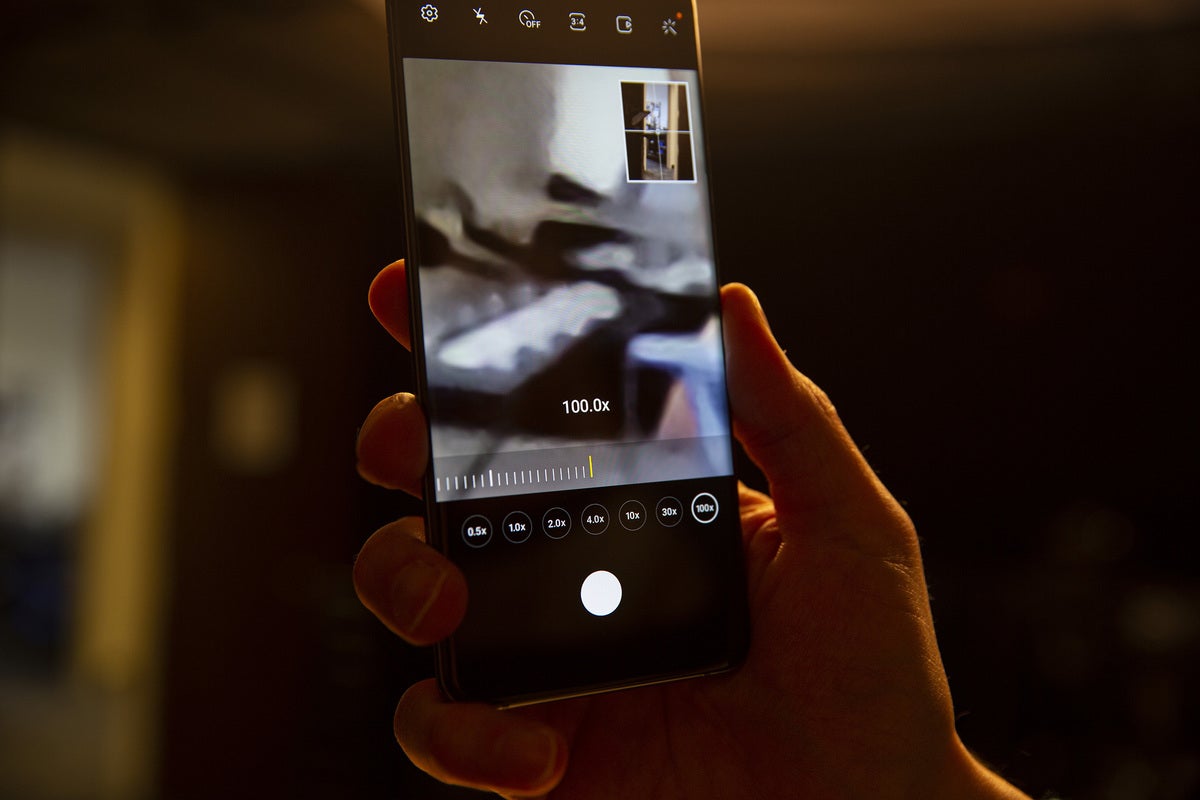 Christopher Hebert/IDG
Christopher Hebert/IDG
Space Zoom on the Galaxy S20 Ultra is far out.
Far more concerning is how the S20 Ultra's size affects the photography experience. The S20 Ultra is so big that taking it out of my pocket, launching the camera, pointing it at my subject, and tapping the shutter button took several seconds longer than it did on other phones, simply due to the phone and the bump’s tremendous size. It’s a fact that people who really want a 108MP camera and 100X zoom are going to have to deal with, and it should definitely factor into your buying decision.
Should you buy a Galaxy S20 Ultra?
There are three types of people who should spend $1,600 on the top-of-the-line Galaxy S20 Ultra:
1. Samsung fans who will pay anything to have the latest and greatest handset.
2. Smartphone photographers who need the latest and greatest camera.
3. Influencers who have enough money to afford this phone
That’s basically it. Anyone else should look at the S20+, which has many of the same features and specs minus some of the camera stuff, or even the S10+, which received a permanent $150 price cut.
Don't get me wrong: The S20 Ultra is a great phone, definitely in contention for the best Android phone ever made. But for most people, it’s just too much phone for too much money.





